Best ISO for low noise on Canon 5D mk2
14 Comments
What ISO should you use for lowest noise ? Everybody knows that low ISO will result in lower noise and high ISO will result in higher noise.
But is it a continuum, as one would intuitively think, or are some ISOs better than others ? In the past, I had seen advise to use only whole f-stop ISOs (100,200,400,800,1600,…) because intermediate ISOs were presumably “interpolated” and therefore worse.
I recently watched part of a DSLR Video online class given by Vincent Laforet for creativeLIVE. There was plenty to learn on the video side. As a still photographer what surprised me the most was his statement that with Canon cameras (his experience was with 1D4, 5Dmk2, and 7D), one should shoot at multiples of ISO 160 for lowest noise. For example he mentioned that there was less noise at ISO 1600 than at ISO 1250.
This piqued my interest enough that I decided to conduct a “scientific” test myself. Instead of just relying on visual estimation, I would make actual measurements using Imatest software. As readers of this blog know, in the past, I had extensively used Imatest to assess lens quality, but the software has many modules that can assess any aspect of image quality.
I photographed a Kodak Q13 greyscale with a Canon 5Dmk2, using ISO values from 50 to 6400. The images were shot in RAW, and then converted to JPG with all settings zeroed, and resized down to 2600 pixels wide. Since noise is problematic only in the shadow areas, I restricted the analysis to the 10 darkest patches of the chart, using the Imatest Stepchart module.
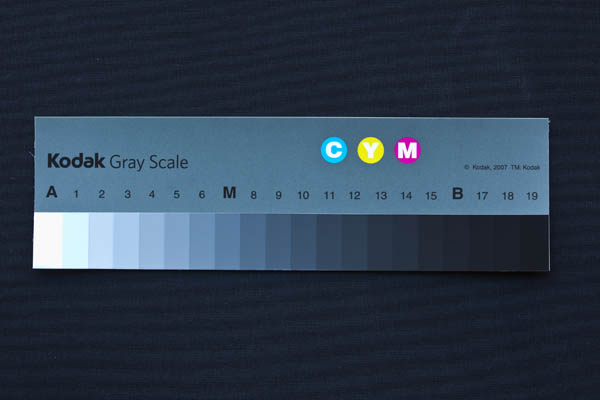
The following graph attempts to summarize the results with a single number, the luminance (Y) noise in pixels. For an explanation of this measurement and how it is computed, please refer to the Stepchart manual page.
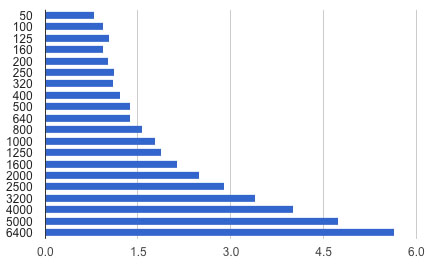
Here are what we can read from the graph:
- Lowest noise is at ISO 50, then ISO 100
- ISO 160 is better than ISO 125, and the same (*) as ISO 100
- ISO 320 is better than ISO 250
- ISO 640 is the same (*) as ISO 500
- Above ISO 640, noise increases as ISO increases
Conclusion: While at high ISOs (above 640) noise behaves as expected, at lower ISOs 160 multiples do provide the best results. More precisely, compared with the 1/3 lower ISO value, 160 multiples provide less noise and 1/3 higher speed. 160 may even be a better choice than 100, since it provides 2/3 higher speed and essentially the same noise. The exception is the special ISO setting of 50, which provides the less noise of all, but at the expense of less dynamic range.
What do you think ? Consistent with your observations ? (Scroll down past graphs to see comments)
For reference, I am providing below the numeral values, and then complete output of the calculations. Again please refer to the Stepchart manual page for explanations.
ISO Noise 50 0.80 100 0.94 125 1.04 160 0.95 200 1.03 250 1.13 320 1.11 400 1.22 500 1.38 640 1.39 800 1.57 1000 1.78 1250 1.89 1600 2.14 2000 2.50 2500 2.91 3200 3.41 4000 4.02 5000 4.75 6400 5.65
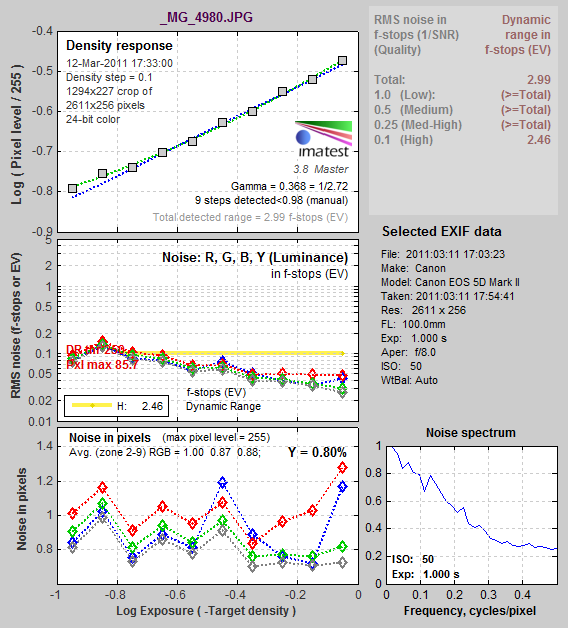
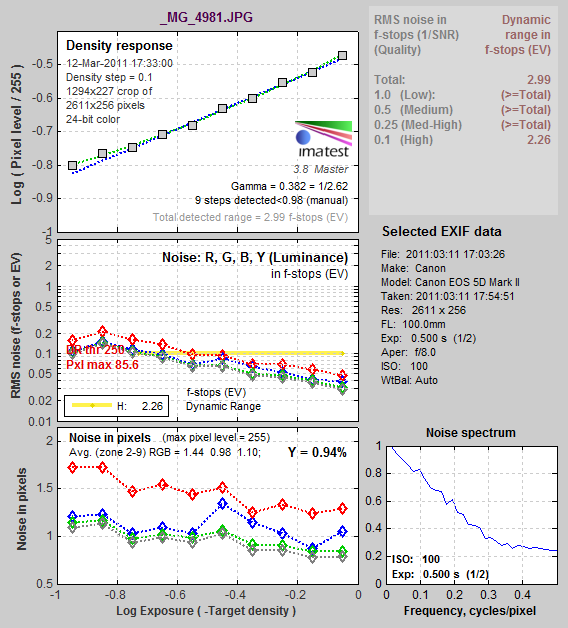
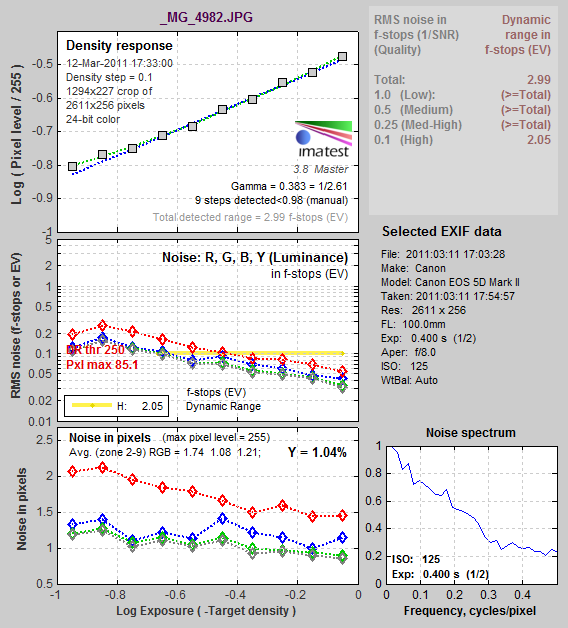
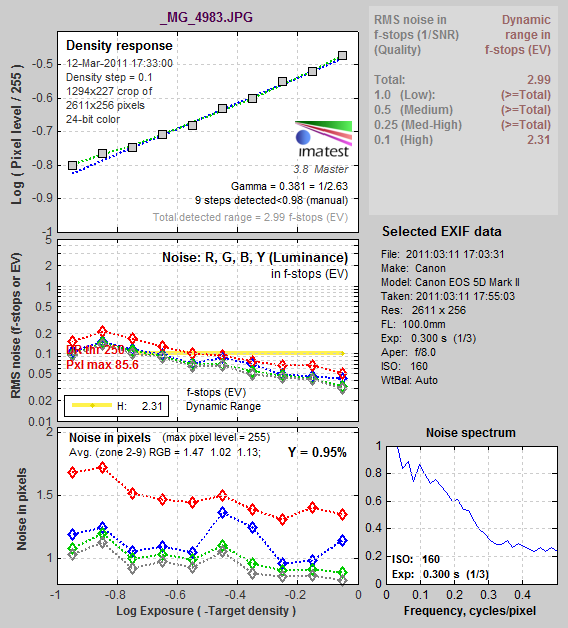
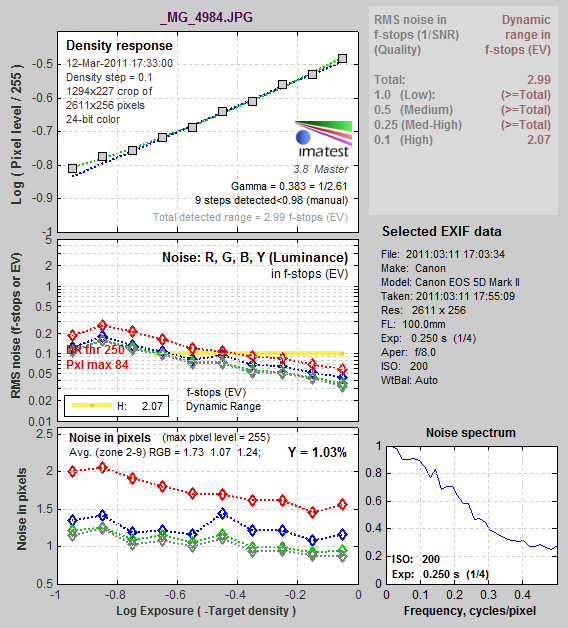
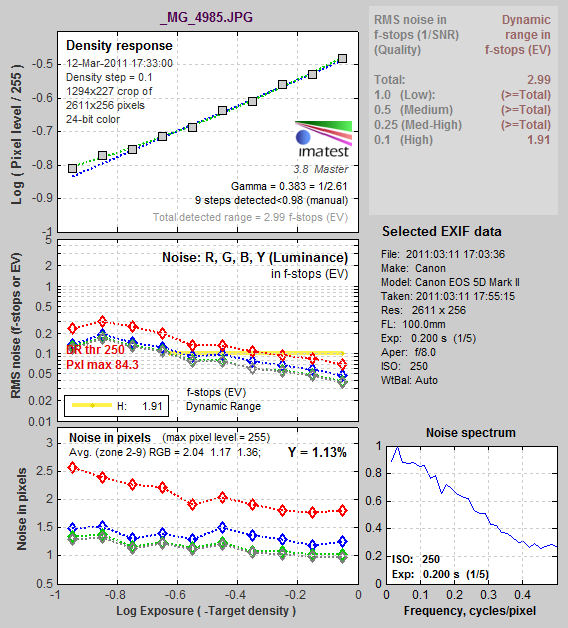
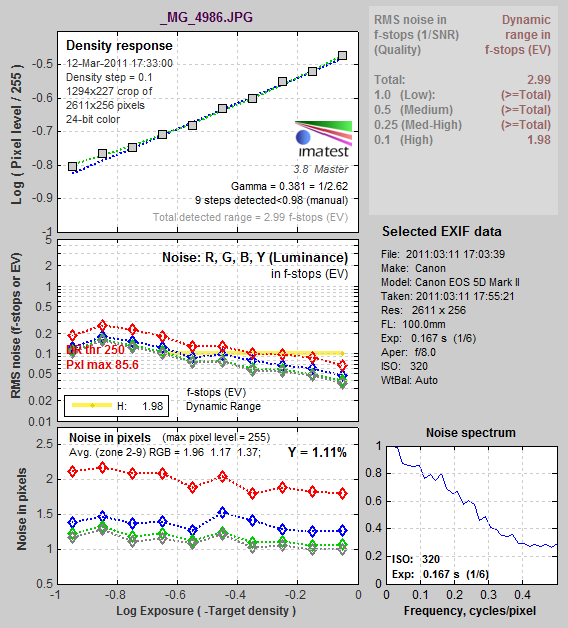
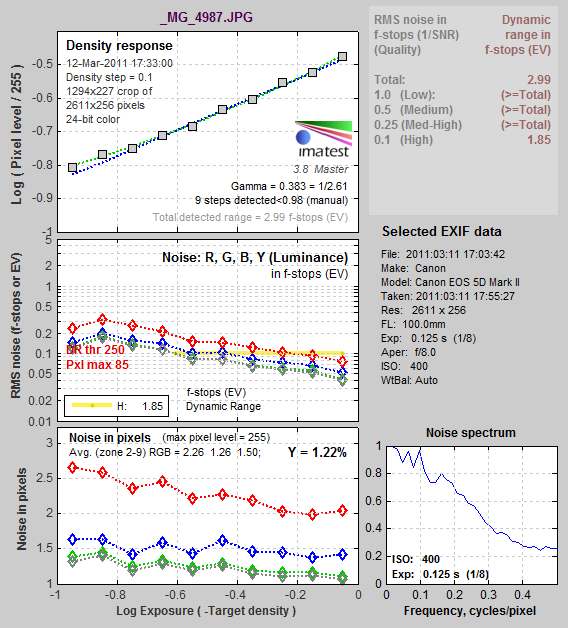
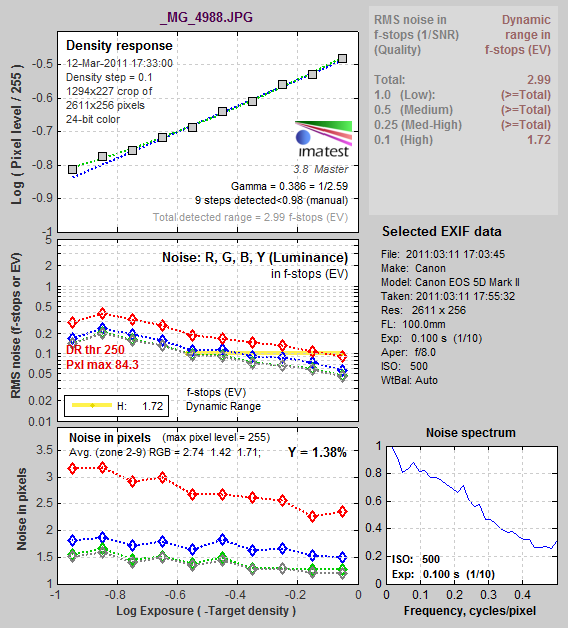
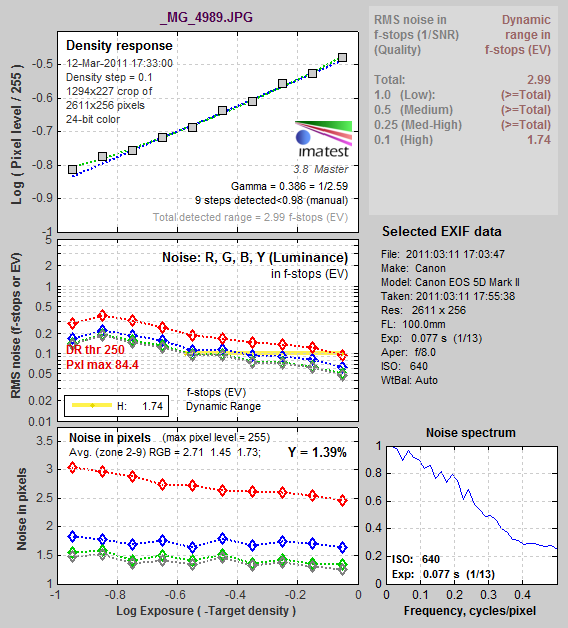
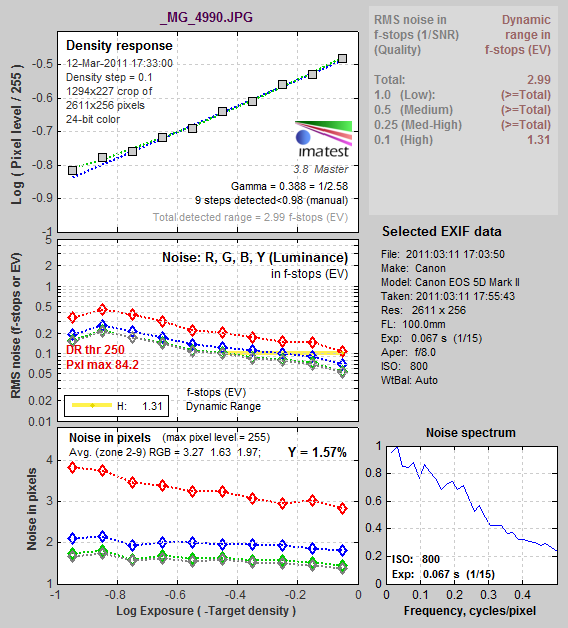
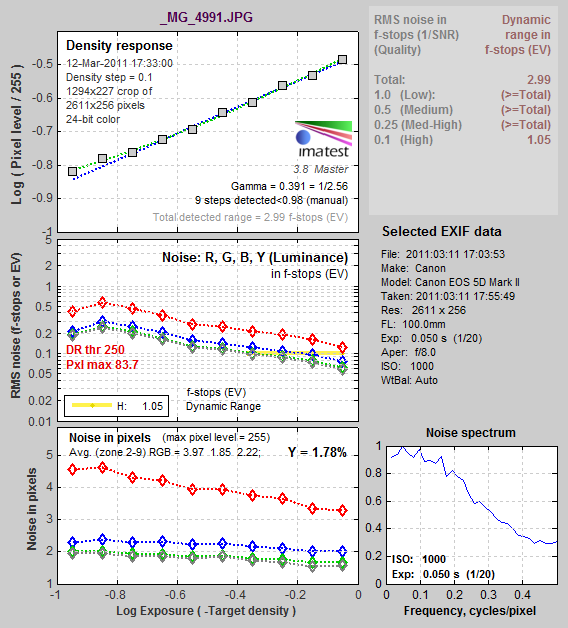
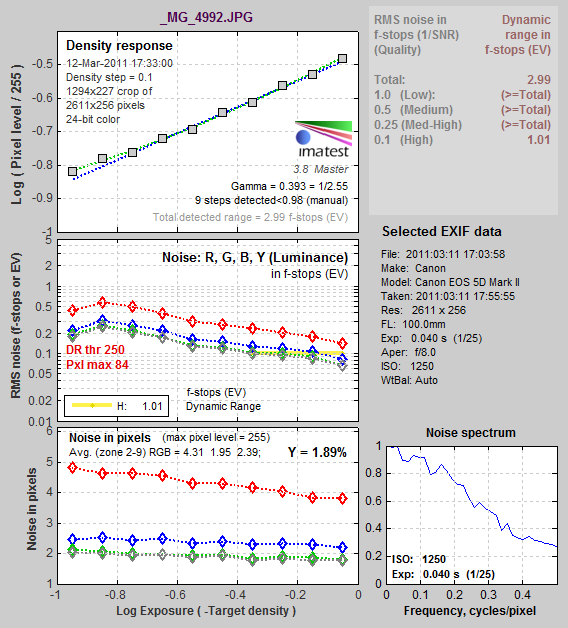
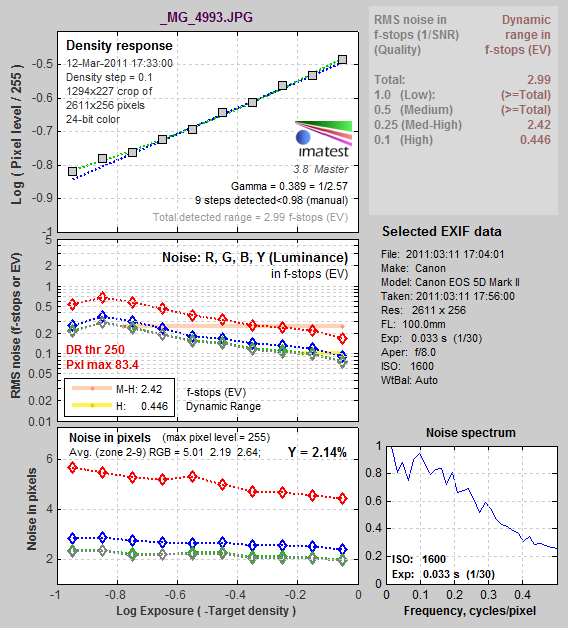

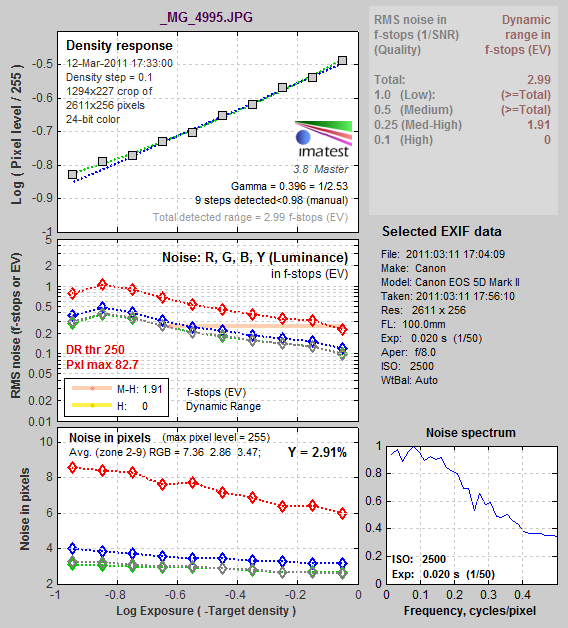
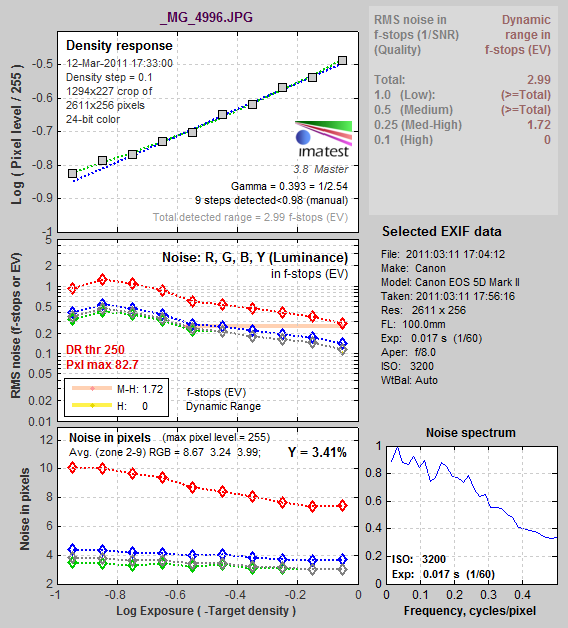
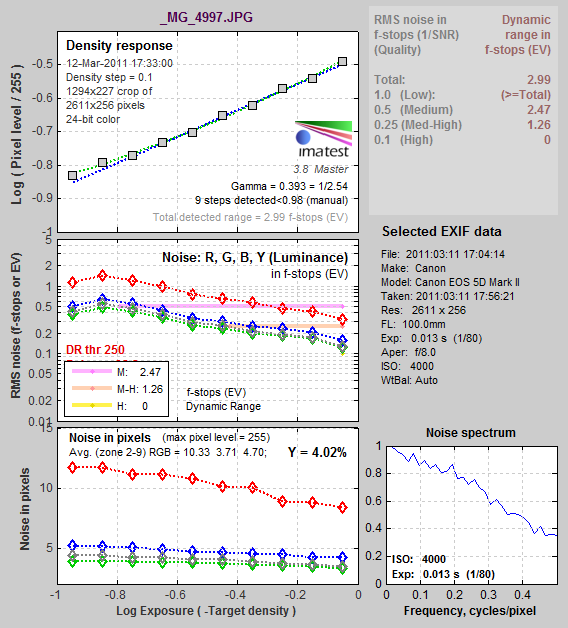
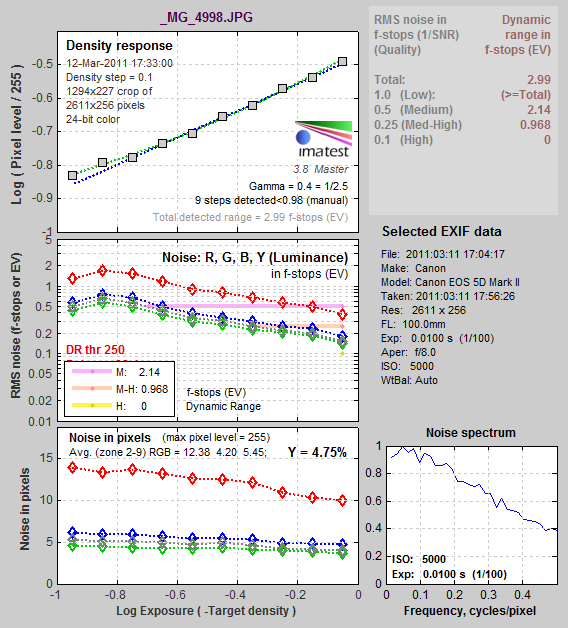
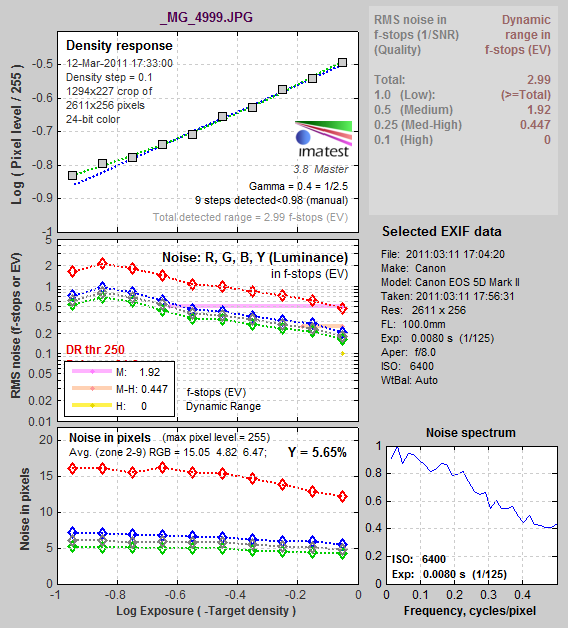


But you should also take dynamic range into an account. At ISO 50 highlights suffer a severe loss of details.
That’s right. In fact the two brightest steps are clipped at ISO 50.
This post investigates only one aspect of image quality (IQ) namely noise. But I did mention in the conslusion “the special ISO setting of 50, which provides the less noise of all, but at the expense of less dynamic range.”
@LewisCollard on Twitter has questioned results because I imported in JPEG. What this misses is that the value of the Imatest numbers is only relative, not absolute. In other words, what is interesting is ISO 160 has lower noise than ISO 125, not that ISO 160 has “0.95” noise and ISO 125 has “1.04”. JPEG compression is just not going to invert the noise levels of two images. Generally speaking JPEG compression is not going to invert *any* aspect of IQ.
I’ve always assumed I should avoid the “intermediate” interpolated ISOs because they are interpolated and that could lead to higher noise, so this is interesting.
The luminance noise value differences here are very small in some cases (0.14 for ISOs 50 vs. 100); how does this translate into observable decline in image quality? My own observations are that its barely noticeable. Also, because of the low values for differences between some ISOs, do you think there would be copy variation between enough bodies to make this difference go away? In other words, do you think it would be statistically significant?
Cheers,
Greg
Why on earth did you resize them down to 2600px before testing? 2600 into 5616 does not go(TM): by my calculation, you’ll be introducing interpolation artefacts every 6 or 13 pixels (ish), at the expense of seeing what the pixels are actually doing. I cannot see the point in that at all.
Greg, good question. I have a second 5Dmk2, so I may test it as you suggest. Stay tuned.
Tim, this is recommended in the Imatest manual that I linked to. The reason is that if the resolution you use is too high, you might pick up some texture from the printing pattern on the chart. But you have a point that maybe I should have resized by an even ratio, so I might try that again.
Thanks for the response, QT (oh, don’t I feel weird calling you that). It’s not JPEG as such, it’s the fact that you’ve introduced two variables into the equation. They may affect things, they may not, but those things should be eliminated to the extent that’s possible.
A few more things. First, if your filenames are telling us anything, you’ve only tested it with a single shot at each ISO. Noise is random; if a wind blew in from Japan’s direction during the ASA 100 and 125 shots, that could really screw up your results. 😉 A better way would have been to take several shots at each ISO and then average them.
Second, you’re not keeping the exposure time the same with each shot. A side-effect of this is that you’re also finding out about noise patterns in your test environment at different exposure speeds. This might lead to a *consistent* skew, or it might not. (Unfortunately, doing it the other way (by varying aperture) would have the effect of testing how well your aperture is calibrated…)
On that note, are you sure that there aren’t any variations in exposure here that could mess with your results? At ASA 100 and 500ms and 125 at 400ms, that’s 100 * 500 = 50000, but ISO 160 at 300ms = 160 * 300 = 48000. Assuming ASA 100, 125 and 160 are what they say they are, that’s a 2% variation, as I see it, which might actually make your case *stronger*…
Regardless, it’s interesting research; I like it when people actually test these things rather than take anyone else’s word for it, so don’t take my attitude on Twitter (which is far poorer than it should be, sorry about that) as saying otherwise. I’d be interested in any further work you do on this count. Be well!
Since brightness values go from 1-256 and computers are really binary and not decimal, the supposition that we should avoid interpolated settings is actually correct! But contrary to popular belief, ‘true’ ISO settings go like: 80,160,320,640, while 100,200,300 are actually interpolations!!
Patrick
ISO50 is fake as well as all the intermediate ISOs and 6400+ in the 5DII.
At ISO50 the camera takes the shot at ISO100 overexposing 1 stop and flags the RAW as “please pull down exposure 1 stop” so it’s exactly the same as shooting at ISO100 and overexposing.
The fake ISOs only make sense for JPG shooters, for RAW shooters you only lose dynamic range and win nothing.
Real ISOs on the 5DII are 100,200,400,800,1600 and 3200. In fact for RAW there is little difference between 3200 and 1600 a pushed 1600 shot.
The reason why ISO160 is so popular is because it’s a ISO200 shot exposed to the right by the camera. When you use ISO160 the camera takes the shot at ISO200 and then pulls back the exposure 1/3 of a stop. The result is the same as a ISO200 shot Eexposed to the right 1/3 of a stop and that’s why it seems to have less noise.
The signal to noise ratio improves as the ISO goes higher. To avoid noise the recipe is “Expose to the right, then ISO to the right”. Expose as much as you can for the conditions and then if you still have room in your highlights increase the ISO as much as you can.
F8 1/200 ISO100 has more noise than F8 1/200 ISO200 (note same exposure time)
Luis
Good theory Luis. Does anyone has the real scoop on this? How do we know the inner workings for sure?
Patrick
Patrick
It’s not really theory.
About the real vs fake ISOs you can just analyze a RAW file comparing the histogram of the fake ISO vs the closest native ISO and you will see they are the same. Some people already did this the late and great Gabor, Daniel Browning and Guillermo Luijk come to my mind.
I have Guillermo’s article bookmarked: http://www.guillermoluijk.com/article/isos5dmkii/index.htm
Unfortunately it’s in spanish. Daniel’s and Gabor’s showed the same.
About why higher ISOs have a better S2N response there is a very nice paper by Emil Martinec, that goes a lot beyond that subject:
http://theory.uchicago.edu/~ejm/pix/20d/tests/noise/
I do a lot of astrophotography and in that field noise is everything, the easy recipe is to avoid fake and intermediate ISOS if you shoot RAW , and put the histogram as much to the right as you can, using longer exposures as the #1 priority and the ISO when you can’t expose longer (because of movement, star trails, etc)
FWIW, I thought I’d add this: From my own testing, I’ve found that exposures made at the expanded ISOs are not as accurate as those made with the calibrated ISOs (100, 200, 400, etc)… so while noise at ISO 160 is effectively the same as noise at ISO 100, the exposure isn’t quite as accurate and dynamic range also suffers a little (although not as much as at ISO 50).
QT, thanks for your research on this question. It seems to me that there are several interesting things to take away here, including:
1. Anyone who worries about increasing ISO a bit from a “normal” value like 100, 200, 400, and so forth probably should not forego a bit of higher OSO when needed due to concerns over increased noise.
2. It seems that even in those situations in which noise varies among these “partial stops” that the variations are so tiny as to likely be invisible in virtually all photographs and probably undetectable even in careful side by side comparisons of prints.
3. It is worth keeping in mind the meta-question of just how important image noise is in the end. Quite often (though not quite always) we are worrying about noise that is literally not visible in prints, or when visible is so minor (especially compared to film grain) that it is inconsequential. It might even be a bit pleasing!
4. My real world experience with the 5D2 convinces me that it really doesn’t matter in terms of noise whether I shoot at ISO 100 or 200. I think I can see a difference at 400 on the screen, but I’ve shot landscapes (!) at 400 and not noticed it in a print.
Thanks,
Dan
Interesting discussion folks. I experimented with long exposure night shots (15min plus) on the 5DII last winter and came to the conclusion based on subjective judgement that ISO 200 was optimum (allowing me to set more optimal apertures for the kind of shots I do) and that noise was similar from there down to ISO 100. This discussion really helps fill in some of the reasoning behind that.
Hello,
may I add my own findings with the EOS 5D Classic:
ISO 160 and multiples perform WORST, noise-wise,
ISO 50 produces the cleanest pictures (no surprise) but at a noticeable dynamic range penalty (highlights tend to be clipping)
ISO 200 has virtually the same noise as ISO 100
ISO 400 and 800 stand out being cleaner than ISO neighbourhood
ISO 1600 and 3200 (H) file more into the main line of increasing noise with sensibility
The bottom line is that I use ISO200 as my “natural” low-ISO landscape setting, followed by ISO 400 – 800 – (1600). Dynamic Range expansion proved useless to me (L=50, H=3200) because they’re realized by in-camera push/pull algorithm.
Kind regards,
Claudio